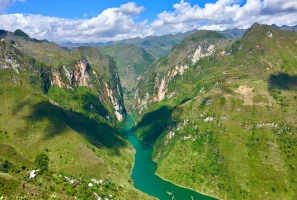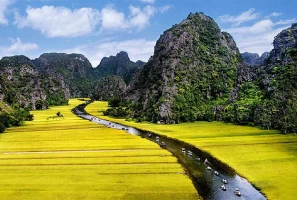A short distance from Da Nang's bustling heart lies Marble Mountain Vietnam, a captivating blend of natural wonder, historical intrigue, and spiritual significance. Prepare to be amazed by its dramatic rock formations, hidden caves, and ancient pagodas nestled amidst lush greenery. Frontier Travel Vietnam will help you explore essential information on navigating transportation, the best things to see and do, and even insights into the local weather.

1. An overview of Marble Mountains Vietnam
Standing sentinel over Da Nang's coastline, the Marble Mountains Vietnam, known locally as Ngu Hanh Son (meaning Five Elements Mountains), boast a history steeped in both nature and cultural significance. King Ming Mang bestowed this name in 1825, reflecting the five distinct elements of Eastern philosophy - metal, wood, water, fire, and earth - embodied by each mountain within the complex.
About Marble Mountains Vietnam, legend speaks of a dragon laying an egg on Non Nuoc Beach, which miraculously cracked into five pieces, transforming into the very mountains we see today. Over time, Ngu Hanh Son evolved into a spiritual sanctuary, adorned with grottoes, pagodas, and temples, reflecting the influence of Mahayana Buddhism. Today, this captivating landscape offers a glimpse into Vietnam's rich cultural tapestry, where nature and faith intertwine.
2. What is the weather like in Marble Mountains Vietnam
If you want to travel in the Marble Mountains Vietnam, the best time is during spring (February - May) or summer (June - September). In the spring, the weather of Marble Mountains Vietnam is dry weather with captivating blue skies and comfortable temperatures hovering around 25 - 26°C, so you can easily and happily explore this place.
In the summer, the weather of Marble Mountains Vietnam is warmer, ranging from 30 - 36°C, early mornings (07:00 - 09:00 AM) and late afternoons (04:00 - 06:00 PM). This weather provides travelers a cooler reprieve for a more relaxed hike. You need to remember to pack plenty of water, comfortable clothing, and sturdy shoes for navigating the terrain.
In October and November, heavy rains in the Marble Mountains can dampen your experience. So, you still could visit this time but avoid being late.
3. What things to do and see in Marble Mountains, Vietnam?
Besides Marble Mountains Vietnam' hidden gems beyond its name and history, Frontier Travel Vietnam will present you must-visit attractions that will leave you spellbound.
The five Marble Mountain
The five Marble Mountains are wonderful sights for you to travel in Marble Mountain Vietnam. The five Marble Mountains attract travelers with a captivating blend of natural wonder, cultural immersion, and historical intrigue.
These five majestic peaks, each named after a different element, offer a treasure trove of discoveries waiting to be unearthed.
Mountain | Outstanding features |
Thuy Son (Water Mountain) | The largest and most visually stunning, takes center stage. Here, you'll find yourself surrounded by breathtaking beauty, from panoramic vistas to hidden caves and grottoes. |
Kim Son (Metal Mountain) | Boasts the renowned Quan The Am Pagoda, a testament to Vietnam's rich spiritual heritage. |
Moc Son (Wood Mountain) | Houses the intriguing Co Mu Stone, a natural formation that bears an uncanny resemblance to the human form. |
Tho Son (Earth Mountain) | The lowest and longest of the five, provides a unique perspective on the surrounding landscape. |
Hoa Son (Fire Mountain) | Aptly named for its fiery red rock face, shelters two additional mountains within its embrace. |
As you explore the network of caves, tunnels, temples, and pagodas that dot the Marble Mountains, prepare to be captivated by the sheer diversity of this natural and cultural wonder. Each turn unveils a new marvel, offering a glimpse into Vietnam's fascinating history and vibrant traditions.
Linh Ung Pagoda
The crown jewel of Marble Mountain, Linh Ung Pagoda, beckons visitors with its grandeur. As you ascend the mountain, this magnificent pagoda announces its presence with a breathtakingly detailed archway, perfectly framing the panoramic view of Non Nuoc Beach. Take a moment to capture this postcard-perfect scene before stepping into the serene courtyard.
Here, tranquility reigns. Lush greenery surrounds small lotus ponds, their gentle ripples reflecting the vibrant colors of the pagoda's intricate tilework. Bonsai trees, meticulously sculpted and bursting with life, add a touch of artistry to the landscape.
Stepping inside the main structure, a sense of history washes over you. Built in 1825 by the order of Nguyen Emperor Gia Long, the pagoda's design echoes the motifs found in Hue's UNESCO-listed tombs. Linh Ung Pagoda is more than just a religious site; it's a captivating blend of history, art, and breathtaking natural beauty, offering a glimpse into Vietnam's rich cultural heritage.
Xa Loi Tower
Just steps from the awe-inspiring Linh Ung Pagoda lies Xa Loi Tower, a beacon of spirituality. Within its seven stories, 200 exquisite Buddha, Bodhisattva, and Arhat statues reside, offering a tranquil haven for reflection and reverence.
You can see a colossal 10-meter Buddha statue standing guard, radiating serenity. But the true marvel lies within the Xa Loi Tower. Built in 1997, this 28-meter tall structure boasts a staggering 7 floors, each housing a collection of 200 Buddha, Bodhisattva, and Arhat statues. This impressive feat of construction holds the title for the largest number of stone statues in all of Vietnam.
Tam Thai Pagoda
Nestled amidst the serene beauty of Water Mountain, Tam Thai Pagoda whispers tales of its rich history. Built in the 17th century under the Le Dynasty, this ancient pagoda exudes an air of tranquility.
The entrance, marked by a symbolic three-door gate, reflects Buddhist principles. The central doorway, reserved for monks, represents the path to enlightenment, the left one is for males and the right one is for females. This is a testament to the balanced order of the universe.
Over the centuries, Tam Thai Pagoda has undergone restorations, ensuring its legacy endures. Recognized as a National Historical-Cultural Heritage Site, it beckons not just for its architectural beauty but also as a spiritual haven for Buddhists seeking solace and connection.
Discovering caves
Among the caves in Marble Mountains Vietnam, the two most famous and attractive caves to visit are Huyen Khong Cave and Am Phu Cave.
Huyen Khong Cave
Huyen Khong Cave stands as a testament to both breathtaking beauty and historical significance. Sunlight streams through the cave's open structure, illuminating a magnificent Buddha statue and creating an awe-inspiring spectacle. Two smaller temples, Chua Tien and Thuong Ngan, flank the entrance, offering solace to those seeking blessings of health and prosperity.
However, Huyen Khong Cave's story extends far beyond its visual splendor. This revered location has witnessed centuries of transformation and played a pivotal role in Vietnam's turbulent history. The Marble Mountains, its home, have served as a strategic military base throughout various conflicts.
During the French Colonial War, the cave became a clandestine sanctuary for local revolutionaries. The Second Indochina War saw it repurposed as a training ground for American and South Vietnamese forces. In 1968, the Viet Minh captured the area, transforming Huyen Khong Cave into a crucial medical facility for their liberation army. Thus, Huyen Khong Cave transcends its role as a natural wonder; it's a captivating window into Vietnam's rich and often tumultuous past.
Am Phu Cave
Carved into the heart of Marble Mountain lies Am Phu Cave, a stark contrast to the ethereal beauty of Huyen Khong Cave. "Am Phu" translates to "Hell," and this 302-meter-long cavern serves as a chilling illustration of the Buddhist concept of hell - a realm awaiting those who stray from the righteous path.
The natural rock formations of Am Phu Cave have been transformed into a powerful tableau. Intricate sculptures depict scenes of torment, a visceral reminder of the karmic principle - every action has a consequence. Visitors are confronted with harrowing depictions of suffering, a stark message about the consequences of wrongdoings in one's past life.
Towering arches, reaching heights of 40 to 50 meters, amplify the dramatic effect, creating an immersive and spine-chilling experience. Am Phu Cave isn't just a cave; it's a powerful allegory, urging visitors to contemplate the choices they make and the potential repercussions of their actions.
4. FAQ about Marble Mountains, Vietnam?
Here are some questions that tourists often encounter when visiting the Marble Mountains Vietnam. Let's find out details with Frontier Travel Vietnam!
How to get to Marble Mountains Vietnam?
Before you embark on the captivating journey of Marble Mountain Vietnam, you need to learn more about the way to get to this majestic wonder:
Start from Hanoi:
The following are two types of means of transport that tourists often choose to get from Hanoi to Da Nang:
- Train: For a scenic journey, book a train ticket from Hanoi Railway Station to Da Nang Railway Station. The ticket cost is economical, about $64/person.
- Plane: If time is of the essence, hop on a flight from Noi Bai International Airport to Da Nang International Airport. The one-way ticket cost is from $83 - $130/person.

Upon Arrival in Da Nang:
Several convenient transportation options await you, depending on your budget and preferences:
- Bus: The most economical option is bus number 1. The ride takes approximately 20 minutes, with tickets costing around $0.80 per person.
- Taxi: For a hassle-free experience, hail a taxi like Vinasun or book a ride through a service like Grab. Consider trying Vinfast Electric Taxi for a more eco-friendly and potentially more affordable option.
- Motorbike: Embrace the freedom of a motorbike rental, allowing you to explore Da Nang at your own pace. However, ensure you have a valid motorbike license and feel comfortable navigating Vietnamese traffic.
No matter your chosen mode of transportation, you'll be at the foot of Marble Mountain Vietnam within 30 minutes, ready to ascend and discover its hidden treasures.
How much is the Marble Mountains' entrance fee?
Adult admission (ages 6 and above) is a budget-friendly 40,000 VND, granting access to the main entrance, visiting Water Mountain (Thuy Son) and its surrounding sights. Children under 6 are exempt from the entrance fee.
Exploring the Am Phu Cave - near the elevator and car parkings, requires a separate 20,000 VND ticket for adults and individuals above 6 years old, with free entry for younger visitors. The rest of the Marble Mountains offer open exploration without additional fees.
For those seeking to bypass the 132 steps leading to the Linh Ung Temple, a convenient elevator option exists. This service is particularly helpful for seniors, children, or those with accessibility limitations. Tickets for this one-way journey cost 15,000 VND for adults and individuals above 6 years old, while younger visitors ride free.
As the Marble Mountains' popularity has surged in recent decades, pre-booking your tickets can be a wise move to avoid queuing delays. This ensures a smooth and hassle-free start to your exploration of this captivating natural wonder.
Things to note when visiting Marble Mountains, Vietnam?
Conquering Marble Mountain Vietnam requires preparation for both comfort and exploration! Here are some key tips:
- Tread carefully: The paths can be slippery, so opt for sturdy hiking or walking shoes for optimal traction.
- Elevator option: If you're traveling with elderly companions or simply want to save energy, consider using the convenient elevator to reach the peaks.
- Unlock the history: Enhance your experience by hiring a tour guide. They'll unveil the fascinating historical significance hidden within these majestic mountains.
- Treasured souvenirs: Don't miss the opportunity to commemorate your visit! Browse the selection of unique souvenirs and exquisite stonework, perfect as gifts or cherished keepsakes.
- Be prepared: Pack some cash for unexpected expenses and avoid peak times like rainy days or scorching afternoons.
- Respectful attire: Opt for modest clothing. Opting for long sleeves and pants ensures you'll feel comfortable and respectful as you explore the cultural and religious sites.
By following these tips of Frontier Travel Vietnam, you're guaranteed a smooth and enriching adventure at Marble Mountain Vietnam!
A must-visit in Da Nang, Marble Mountain Vietnam's unique charm captivates both local and international tourists. Frontier Travel Vietnam has just introduced you to outstanding attractions and important notes to visit at Marble Mountains Vietnam. If you want to learn more about travel information, especially motorbike tours, let’s refer to our blog for detailed reviews!



















.png)